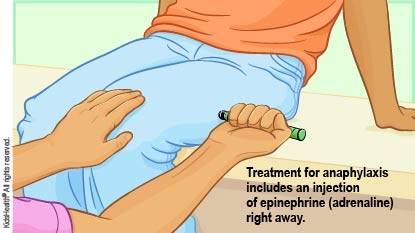- Home
- Parents Home
- Allergy Center
- Asthma Center
- Cancer Center
- Diabetes Center
- A to Z Dictionary
- Emotions & Behavior
- First Aid & Safety
- Food Allergy Center
- General Health
- Growth & Development
- Flu Center
- Heart Health
- Homework Help Center
- Infections
- Diseases & Conditions
- Nutrition & Fitness Center
- Play & Learn Center
- School & Family Life
- Pregnancy Center
- Newborn Center
- Q&A
- Recipes
- Sports Medicine Center
- Doctors & Hospitals
- Videos
- Para Padres
- Home
- Kids Home
- Asthma Center
- Cancer Center
- Movies & More
- Diabetes Center
- Getting Help
- Feelings
- Puberty & Growing Up
- Health Problems of Grown-Ups
- Health Problems
- Homework Center
- How the Body Works
- Illnesses & Injuries
- Nutrition & Fitness Center
- Recipes & Cooking
- Staying Healthy
- Stay Safe Center
- Relax & Unwind Center
- Q&A
- Heart Center
- Videos
- Staying Safe
- Kids' Medical Dictionary
- Para Niños
- Home
- Teens Home
- Asthma Center
- Be Your Best Self Center
- Cancer Center
- Diabetes Center
- Diseases & Conditions
- Drugs & Alcohol
- Expert Answers (Q&A)
- Flu Center
- Homework Help Center
- Infections
- Managing Your Medical Care
- Managing Your Weight
- Nutrition & Fitness Center
- Recipes
- Safety & First Aid
- School & Work
- Sexual Health
- Sports Center
- Stress & Coping Center
- Videos
- Your Body
- Your Mind
- Para Adolescentes
Serious Allergic Reactions (Anaphylaxis)
What Is Anaphylaxis?
Anaphylaxis is a severe allergic reaction that can be life-threatening. Things that can cause allergic reactions are called allergens.
Anaphylaxis (an-eh-fih-LAK-siss) most often happens during allergic reactions to:
- foods
- insect stings
- medicines
- latex
Anaphylaxis can be scary. But being prepared will help you treat a reaction quickly.
What Are the Signs & Symptoms of Anaphylaxis?
Severe allergic reactions can cause:
- trouble breathing
- throat tightness or feeling like the throat or airways are closing
- hoarseness or trouble speaking
- wheezing or cough
- nasal stuffiness
- nausea, belly pain, vomiting, and/or diarrhea
- trouble swallowing or drooling
- low blood pressure
- skin itching, redness, or swelling
- hives
- a feeling like something bad is about to happen
- passing out
Anaphylaxis can cause different symptoms at different times. An allergic reaction is considered anaphylaxis if someone has:
- any severe symptoms, such as trouble breathing, repeated vomiting, passing out, or throat tightness
or - two or more mild symptoms, such as hives and vomiting or coughing and swelling
A person with symptoms of anaphylaxis needs treatment right away.
How Is Anaphylaxis Treated?
Someone with anaphylaxis needs help right away. The reaction can get worse very quickly. Doctors usually want people with severe allergies to carry epinephrine auto injectors. The medicine epinephrine enters the bloodstream and works quickly against serious allergy symptoms. The injectors should always be with a child who has severe allergies, including at school, sports, jobs, and other activities. The auto injectors are small and easy to use.
If the doctor prescribes epinephrine auto injectors for your child, they will show you how to use them. Two auto injectors should always be with your child in case one injector does not work or your child needs a second dose.
The doctor also might instruct you to give your child antihistamines in certain cases. But always treat a serious reaction with epinephrine. Never use antihistamines instead of epinephrine in serious reactions.

What Should I Do If My Child Has a Serious Reaction?
Time matters during anaphylaxis. If your child shows signs of a serious allergic reaction:
- Give the epinephrine auto-injector right away. If you are alone with your child, give this medicine first, then call 911. If someone is with you, have the person call 911 while you give the epinephrine.
- Lay your child down with legs raised while you wait for the ambulance.
- Go to the emergency room, even if symptoms improve after epinephrine. Your child must be under medical supervision for several hours. This is because a second wave of serious symptoms (called a biphasic reaction) can happen. Your child can get more treatment at the emergency room, if needed.
What Else Should I Know?
Serious allergies can be scary. To help keep your child safe:
- Help your child avoid allergens.
- Always have two epinephrine auto injectors with your child.
- Tell any caregivers, teachers, or coaches about your child's allergy and be sure they know what to do in an emergency.
- Check that your child's auto injectors have not expired and don't get too hot or too cold.
- Have your child wear a medical ID bracelet so others know about your child’s allergies and know to use the epinephrine auto injectors in case of an emergency.

© 1995- The Nemours Foundation. KidsHealth® is a registered trademark of The Nemours Foundation. All rights reserved.
Images sourced by The Nemours Foundation and Getty Images.
